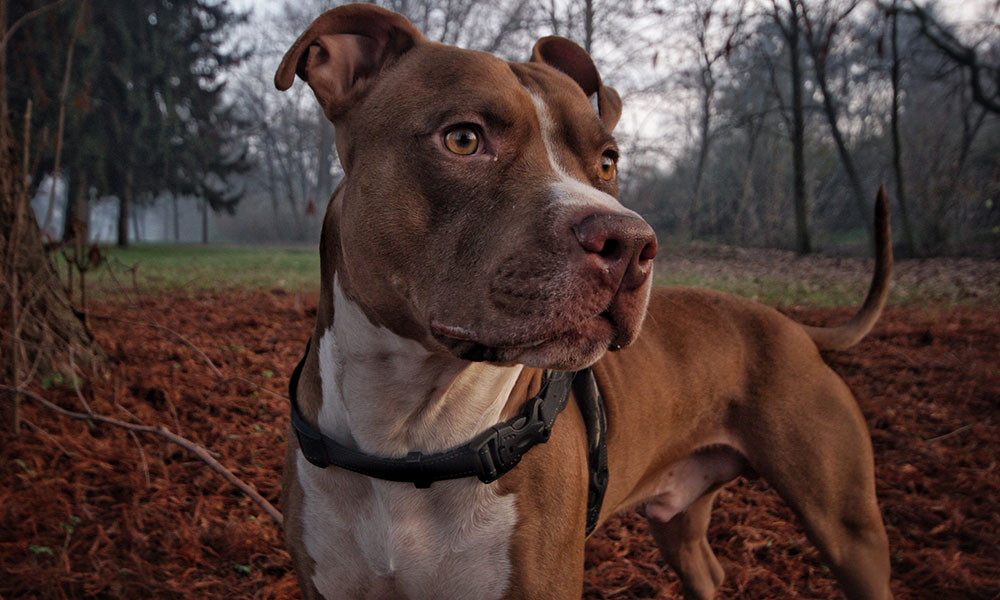Pit bulls get a bad wrap. It’s unfortunate that such a clownish, lovable and loyal dog is often portrayed as hyper violent or uncontrolled. The fact of the matter is, animals abide by the old adage of nurture vs nature. Yes, a pit bull can be an aggressive pooch, but that’s only if they have been raised in an aggressive household or suffer from past trauma. This is why training your dogs is an imperative step in becoming a responsible pet owner. Not only will the way we treat our furry-family-members shape the way they treat us, strangers and other dogs they encounter, but so will the environment we surround them in. Training an animal is a long process and owners must be dedicated to the end result. Stopping after a few days, because you’re not seeing results, will only lead to confusion down the road. Expect the process to take weeks and possibly even months of dedication to mould your pupper into the ultimate household companion.

Why Do We Need To Train Our Dogs?

Because, at heart, they’re wild animals. Yes, dogs are domesticated, but deep down they have the ancestors of wolves and crave the hunt. This craving often shows itself in the destroying of your couch cushions or tearing apart of the garbage, but has been shown to produce more severe implications for absentee owners. Guiding this instinct and aggression into a playful trained demeanor will make your life as an animal owner much less stressful and, likely, keep your house from being destroyed. But how do you train your pit bull? After hours of scouring the internet, we have compiled a list of the 10 best pit bull training tips that you can use as an aid. Most, if not all, of these tips can be used for any animal, but some are pit bull specific.
#10 Start Them young
There’s a reason humans start going to school as early as 4 years old. The brain is a sponge at that age. Ever try to teach a 72 year old algebra? It’s not going to go very smoothly. Puppies are curious and eager to learn and so training a pit bull pup is best suited when they’re exactly that: a pup. Remember that they are still a puppy and you’ll need to stay calm and assertive during the training process, but we’ll touch more on that later.
#9 Positive Reinforcement
No matter who you are, it’s nice to hear that you have done a good job after doing a good job. An atta boy/girl always boosts confidence and makes you want to continue to learn more, moving forward. The same goes for your pit bull puppy. Following up a successful “sit” or “stay” puppy command with some happy words and play time will make the training experience more fun for your pit bull training an enjoyable experience for them and not send them running for another room when you approach them for the next lesson.
#8 Teach Them To Be Social
This is probably one of the most important lessons you can teach your pit bull in training. Out of everything in this pit bull training guide, teaching them to be social is imperative. Not only does it give your pit bull pup a great opportunity to make friends and play, but it teaches them to accept other dogs and people without being frightened. Social doesn’t just mean with other dogs either. They should be put into social situations with humans as well. As early as it feels comfortable you should slowly introduce them to men, women, people with glasses, who wear hats, pretty much any combination of people in your life. Dogs, and almost all animals for that matter, rely on their smell to “know” who they’re meeting. That’s why dogs rush to smell each other the moment they meet. Once they have registered the smell of you, your friends or your family, they will remember them and be more comfortable with them upon each subsequent meeting. Obviously you should refrain from jumping on company when they enter the door. Walk a fine line in social freedom and control over their excitement.
#7 Obedience Is Control
This one might take a little bit of finesse when it comes to training your pit bull. In some cases, it might not be until they have matured past puppy-hood before you will be able to instill these types of values in your pup. You can obtain control by trying to ensure that your pet gives you attention when you call for them. You should strive to have your dog maintain eye contact with you and not break that eye contact until you’ve assured them to do so. You can manage this with a mixture of commands and Dog treats. More on the training power of treats later.
#6 Namaste Calm
This is just as much an order for your pit bull training as it is for the owners. Getting visibly worked up will only work up your pup. How can you expect your pit bull to pay attention during training when you are flailing around and raising your voice? Understand that dogs don’t speak English and tend to learn via body language more than spoken language.
#5 Be Patient
This tip goes hand in hand with remaining calm. Pit bull puppy training is likely not going to be as smooth of sailing as you see online or on TV. You’re not the dog whisperer and that’s okay. A lot of training your pit bull is trial and error because just like humans, animals have personalities. Sometimes those personalities clash or make it a little more difficult to concentrate on the task at hand. Finding the best course of action for your pit bull will take time, but once you find the swing of things, it will be exponentially easier than becoming stressed out and impatient while training. It’s a marathon, not a race, and your patience will come in handy when it’s week 2 of trying to teach them how to sit.
#4 Buy Treats
As much as an atta boy/girl can make training a pit bull go relatively smoothly, treats are going to make the entire experience much easier. Let’s be honest, nothing in life is free. The animal kingdom operates with the same values. Your pit bull training is going to go a lot smoother when you present a reward for a job well done. Eventually your pet will correlate listening to your commands with getting a treat. After an amount of time passes you can start to wean them off of the treats (but hopefully not all of them) so that it becomes an instinct when you make your commands.
#3 Start Simple
There’s a reason that almost every dog on the planet understands “sit” and “shake a paw”. They’re easy. Not only for them, but for you. Repetitively repeating the command and action with reward of treats can become extremely exhausting after a few days, if not weeks, so easing them into training is a safe bet. It also gets them into the “learning mode”. Once they’ve mastered the basic commands and understand the command-to-treat rewards system, it will make upping the ante of training easier for the both of you. You’ll have them turning off the lights and bringing you a drink in no time!
#2 Don’t Over Do It
We have said it a few times in this article, but that’s because it is solid knowledge: It’s a marathon, not a race. Don’t turn training into an 8-hour job for your puppy. Remember that a puppy is the same thing as an infantile human. Over doing it can burn them out and make them resistant to further lessons. If you are a keener and like to put in long hours then do your best to break up training with a walk or some play time. If you can find a way to work training into your play time, then even better.
#1 Health
Yes. You’re reading that right. In our opinions, health is the most important tip to consider when trying to train your pit bull puppy. Sure, most animals start off in great shape and can maintain that body weight if they live an active lifestyle, but in the cases of animal rescue, you might be starting off at a disadvantage. A healthy pet will ensure that their quality of life is high, but also stave off any future ailments that might make it more difficult for them to learn the training regiment you’re working to teach them.
Conclusion

Pit bulls are like any other animal that’s out there, they’re a product of their environment. It is our job as pet owners to make that environment as safe, healthy and stress free as can be. Only by ensuring we take those steps can we begin the training of our pit bull puppy or pit bull rescue. Not only is it a learning experience for your pets, but for the owner as well. The way you treat your pit bull during training from a puppy is going to alter the way that they behave as an adult. “Where were the parents” is a valid argument when the line of a well behaved pet and a misbehaved pet is a fine one. Be sure to walk it in a sensible way. Don’t be surprised if the lessons you’re working towards treating your dog, patience, health, socializing etc. don’t rub off on you at the same time. They say that dogs look like their owners for a reason.
Frequently Asked Questions (FAQ)
Are pit bulls easy to train?
Pit bulls are as easy to train as any other dog. They’re smart, inquisitive and loyal and it’s in the way you train your dog that will dictate how difficult the process is.
How do you train a pit bull?
Through a variation of steps. Do you want them to be well behaved and not jump? Focus on teaching control. Do you want them to follow specific commands? A mixture of control and treat-based training will be your best bet.
What are the basic commands to train a pit bull puppy?
The most common commands that a pet owner will train their pit bull, or any other dog for that matter, are: Sit, shake-a-paw and lay down. They’re the most basic because they are the easiest. Once your dog has mastered those, you will be able to shift to more difficult commands.
How do you train a pit bull not to bite?
By training them properly. Pit bulls are often branded as mean or violent animals. That is false. Pit bulls only act in the way that they were raised to act. Avoid tethering them outside, aggressive behaviour, threatening them or using aggressive body language. The same rules apply to other breeds you may be training.
Want to Learn More?
Download our AILMENT GUIDE NOW.
PLUS! all FIRST TIME buyers get 50% off their additional order. Visit verlota.com to get your discount code.





